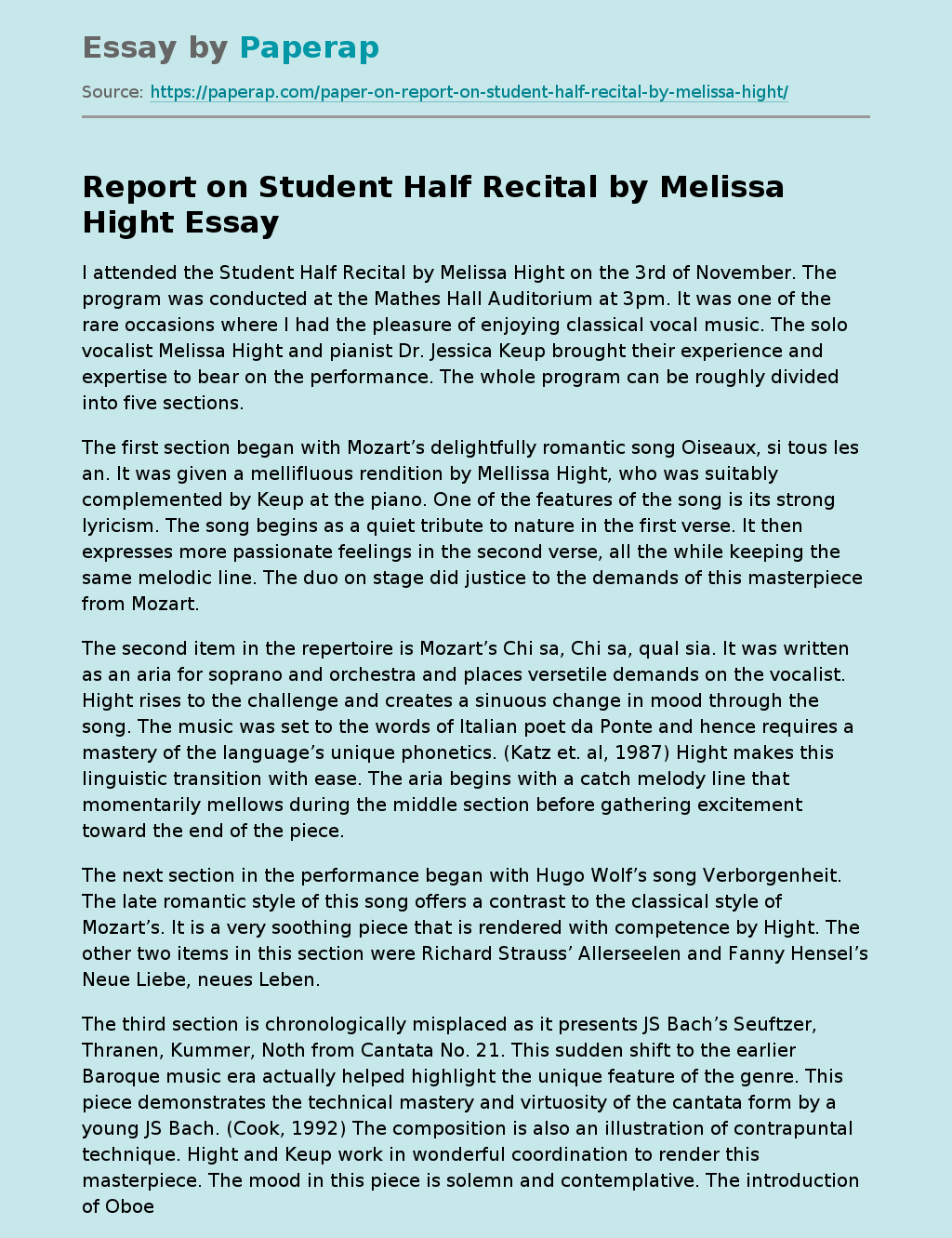My Impression of the Melissa Hight Concert
I attended the Student Half Recital by Melissa Hight on the 3rd of November. The program was conducted at the Mathes Hall Auditorium at 3pm. It was one of the rare occasions where I had the pleasure of enjoying classical vocal music. The solo vocalist Melissa Hight and pianist Dr. Jessica Keup brought their experience and expertise to bear on the performance. The whole program can be roughly divided into five sections.
The first section began with Mozart’s delightfully romantic song Oiseaux, si tous les an.
It was given a mellifluous rendition by Mellissa Hight, who was suitably complemented by Keup at the piano. One of the features of the song is its strong lyricism. The song begins as a quiet tribute to nature in the first verse. It then expresses more passionate feelings in the second verse, all the while keeping the same melodic line. The duo on stage did justice to the demands of this masterpiece from Mozart.
The second item in the repertoire is Mozart’s Chi sa, Chi sa, qual sia. It was written as an aria for soprano and orchestra and places versetile demands on the vocalist. Hight rises to the challenge and creates a sinuous change in mood through the song. The music was set to the words of Italian poet da Ponte and hence requires a mastery of the language’s unique phonetics. (Katz et. al, 1987) Hight makes this linguistic transition with ease. The aria begins with a catch melody line that momentarily mellows during the middle section before gathering excitement toward the end of the piece.
The next section in the performance began with Hugo Wolf’s song Verborgenheit. The late romantic style of this song offers a contrast to the classical style of Mozart’s. It is a very soothing piece that is rendered with competence by Hight. The other two items in this section were Richard Strauss’ Allerseelen and Fanny Hensel’s Neue Liebe, neues Leben.
The third section is chronologically misplaced as it presents JS Bach’s Seuftzer, Thranen, Kummer, Noth from Cantata No. 21. This sudden shift to the earlier Baroque music era actually helped highlight the unique feature of the genre. This piece demonstrates the technical mastery and virtuosity of the cantata form by a young JS Bach. (Cook, 1992) The composition is also an illustration of contrapuntal technique. Hight and Keup work in wonderful coordination to render this masterpiece. The mood in this piece is solemn and contemplative. The introduction of Oboe in this section adds more color to the listening experience. This piece not only brings out the rich musical texture of the Baroque aesthetic but also the profound religious expressivity of the Cantata form.
The fourth section of the performance moves forward to the post Romantic era with a choice of C’est L’extase by Claude Debussy. This is yet another romantic song, full of longing and love. The song comes across as very modern through the implementation of triple-time pulse running through it. There is also irregularity of rhythm to capture the feelings of ecstasy that the song talks about. There is a strong sexual overtone to the song, which is subtly captured by Hight through her vocal modulations. This performance really stood out for the competence and craftsmanship of the two performers on stage. The next item in the fourth section is Reynaldo Hahn’s L’Heure Exquise. This shares some similarities with Debussy’s work in that the two composers were contemporaries and were operating within the same musical epoch.
The final section of the Student Half Recital began with Aaron Copland’s Pastorale. This is well into the modern era and the piece exemplifies the features typifying the era. This essence of this composition is one of celebrating the bounty of nature. (Johnson, 2002) Hence there is buoyancy and the spirit of vivacity evident in the piece. The rendition of Pastorale by Hight and Keup was very competent. Following this was Samuel Barber’s Solitary Hotel. The mood was relaxed and a touch nostalgic. There is an underlying theme of melancholy which the vocal dexterity of Hight succeeds in showcasing. The final piece of the Recital was Charles Ives’ Memories: A Very Pleasant, But Rather Sad. The work adopts a modern musical style both in terms of the musical structure and the subject.
In sum, I thoroughly enjoyed the Student Half Recital program. It introduced me to a rich variety of vocal music, starting from the Baroque era to the Modern era. The effortless transition of Melissa Hight from one language to another left me amazed. Her understanding of the subtleties of period specific language needs to be appreciated. I also learnt about the importance of coordination and synchronization beween the vocalist and accompanying instrumentalist. The manner in which the duo successfully pulled off several challenging compositions suggested the numerous hours of practice that preceded the performance. That’s another lesson that I will carry from this concert – the virtue of practice. Overall, it was a near perfect performance that I was privileged to witness up close.
Works Cited
- Cook, Nicholas. Music, Imagination, and Culture. Oxford: Oxford UP, 1992.
- Johnson, Julian. Who Needs Classical Music : Cultural Choice and Musical Value. New York: Oxford UP, 2002.
- Katz, Ruth, and Carl Dahlhaus, eds. Contemplating Music: Source Readings in the Aesthetics of Music. Vol. 4. New York: Pendragon, 1987.
My Impression of the Melissa Hight Concert. (2019, Mar 01). Retrieved from https://paperap.com/paper-on-report-on-student-half-recital-by-melissa-hight/

